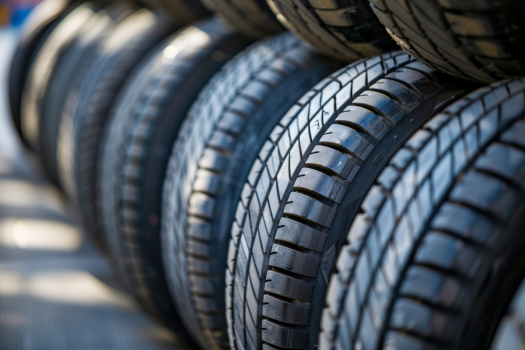Last Updated on April 22, 2024
Tire Lettering Mysteries
White lettering on tires has been a source of aesthetic appeal and practical usefulness in the automotive industry. This style choice, frequently seen on performance and off-road cars, originates in tire manufacturers’ history and marketing tactics. This essay delves into the mysteries of this distinctive tire characteristic and its historical evolution.
Decoding the White Lettering on Tires
White lettering on tires is more than just a visual choice; it combines branding, style, and consumer preference. Initially, the white lettering directly resulted from the tire manufacturing process. Tires are constructed of naturally white rubber compositions. Carbon black was used to boost durability, resulting in black tires. The sidewall portions with brand names and other information preserved the rubber’s natural color, standing out as white against the black tire.
In today’s world, white lettering is more about branding and aesthetics than manufacturing limits. Tire manufacturers utilize it as a branding strategy to make their products readily identifiable. This strategy is widespread in the sports and high-performance vehicle markets, where brand awareness is critical.
Furthermore, many consumers enjoy the unique appearance of white-lettered tires. These customers frequently see their automobiles as an extension of their personalities, and white-lettered tires allow them to customize and differentiate their vehicles.

Historical Perspective of Tire Design
The history of tire design dates back to the late 19th century. The earliest tires were rubber strips attached to wooden wheels, offering minimal traction and comfort. In 1888, John Boyd Dunlop introduced pneumatic tires, which laid the foundation for modern tire design.
Tire technology evolved significantly in the early twentieth century. In 1917, B.F. Goodrich introduced carbon black, which rB.Flutionized tire production. It significantly improved the durability and lifespan of tires, resulting in the ubiquitous black tires we see today. However, white sidewalls or writing remained popular because of their startling contrast and aesthetic appeal.
The mid-twentieth century saw an increase in white-walled tires, particularly in luxury cars. This tendency eventually led to white writing, especially in the sports and muscle vehicle industries. The white writing motif gained traction in the 1960s and 1970s, coinciding with muscle vehicles and a rising motorsport culture.
The white lettering on tires is a fantastic combination of history, technology, and design. From its functional beginnings in tire manufacture to its current role as a fashion statement, it symbolizes the changing face of automobile design and consumer preferences. This feature remains a distinguishing feature of tire design, signifying tradition and modernity in the automotive industry.
The Aesthetics of White Lettering
White lettering on tires is an intriguing combination of visual appeal and strategic branding, deeply rooted in automotive culture and history. This design element, common in performance and off-road vehicles, has more functionality and enters the realm of aesthetics and cultural expression.
The Appeal of Contrast: White on Black
The major attraction of white lettering stems from its sharp contrast against the black backdrop of the tire. This extreme contrast increases the tire’s visual effect and emphasizes its brand and specs. The black-and-white contrast is a timeless design idea that attracts attention and makes a lasting impression. In the case of automobiles, this contrast adds a level of elegance and boldness to the entire design. This feature allows enthusiasts and everyday consumers alike to make a unique statement through their vehicle, demonstrating attention to detail and a taste for style.
Branding and Marketing Strategies
White lettering on tires serves as an intelligent branding and marketing tool. Tire manufacturers use this space as a canvas for their logos and product names, transforming each tire into a mobile advertisement. This type of branding is very effective because it is always visible on the road, attracting the attention of other cars, pedestrians, and enthusiasts. Brands like Goodyear, Michelin, and Firestone have effectively used white lettering to embed their names in public consciousness. This strategy is not just about visibility; it also conveys a message of quality and performance, associating the brand with the high standards expected in the competitive automotive industry.
Influence from Motorsports and Pop Culture
Motorsports have a significant impact on the popularity of white-lettered tires. Historically, race cars and high-performance automobiles frequently used tires with unique white writing. This style became associated with speed, performance, and a competitive edge, attracting vehicle enthusiasts who sought to mimic the appearance of professional race cars. Pop culture has also contributed significantly to the popularity of white-lettered tires. Films, television shows, and music videos depicting cars equipped with these tires help to cement their place in popular culture. They generate remembrance, recalling the golden age of muscle vehicles and the spirit of automotive invention.
The aesthetics of white lettering on tires combine design, branding, and cultural impact. From its practical origins to its current standing as a sign of style and performance, white lettering on tires remains a distinctive and desirable element in the automotive industry. Its continued popularity demonstrates the importance of aesthetics in vehicle design and the long-term influence of racing and pop culture on automotive trends.
Technical Aspects of White Lettering
While the aesthetic appeal of white lettering on tires is often the most noticeable, there are critical technical considerations behind this design choice. The manufacturing processes, materials used, durability concerns, and the impact on tire performance are all essential elements that contribute to the functionality and longevity of white-lettered tires.
Materials and Manufacturing Processes
White lettering on tires requires specific materials and manufacturing procedures. Traditionally, the white lettering came from the natural hue of the rubber compounds used in tire manufacture. Modern tires are primarily constructed of synthetic black rubber due to the use of carbon black for greater strength and durability. The white writing is created using a specially developed rubber compound coating that resists damage and retains its color over time.
This method often includes covering the sections of the tire where the white writing will be put before adding the white rubber compound. The tire is then cured, which involves intense heat and pressure, to guarantee that the lettering is durable and adheres to the tire. Advances in rubber technology and curing methods have enabled more precise and long-lasting lettering.
Durability and Wear Considerations
Durability is a significant concern with white-lettered tires. The white area of the tire is more likely to tarnish and wear than the remainder. U.V. exposure, harsh weather conditions, and repetitive driving on rough surfaces can all cause the white writing to fade or yellow.
To overcome these issues, tire manufacturers often incorporate U.V. protectants and other additives into the whU.V.e rubber compound to enhance its resistance to the elements. Regular maintenance and cleaning are also recommended to keep the white lettering in good condition. However, it’s important to note that despite these advancements, white lettering may still require more upkeep than standard black tires.
Impact on Tire Performance
The effect of white lettering on tire performance is unclear. Adding white lettering has little impact on the tire’s overall performance. A tire’s construction, tread design, and rubber compound define its primary properties, which include grip, handling, and durability. The white lettering, simply a surface layer, has no significant effect on these qualities.
However, in high-performance applications, every detail matters. The increased weight and balance difficulties caused by white letters may be considered in such circumstances. However, these differences are insignificant for the average consumer and have little bearing on the tire’s practical use.
The technical features of white lettering on tires include production procedures, durability, and performance impact. While white lettering is essentially a design feature, its development, and upkeep require a complex interplay of materials science and engineering, demonstrating the tire industry’s commitment to blending style and substance.
Cultural and Historical Significance
Aside from its aesthetic appeal, white lettering on tires has significant cultural and historical value. This feature has played an essential part in the automotive industry, transitioning from a practical requirement to a fashion statement. Furthermore, countless historical examples of white-letter tires leave an indelible impression on the world of automobiles.
White Lettering in the Automotive Industry
The usage of white lettering on tires dates back to the early days of the automobile industry. Initially, tires were exclusively composed of white or light-colored rubber. However, as tire technology advanced and carbon black became widely used for increased durability, the natural white hue of the rubber faded. As a result, white lettering was required to transmit essential tire-related information such as brand names, tire sizes, and specifications.
In the early to mid-20th century, white lettering became equal to quality and performance in the automotive world. Luxury car manufacturers often opted for white-walled tires, showcasing their commitment to excellence. Additionally, it was common practice for racing and sports cars to feature white lettering, adding to their overall beauty and explaining their high-performance capabilities.
Evolution from Function to Fashion
As tire technology advanced, the functional necessity of white writing decreased. Tires grew more durable, reducing the requirement for white text to identify tire parameters. Instead of fading away, white lettering became a fashion statement. This transition represents the auto industry’s capacity to transform a functional feature into a design element.
In the 1960s and 1970s, the muscle car era saw an increase in the popularity of white lettering. Muscle cars, known for their raw power and bold designs, often featured tires with prominent white lettering. This era marked the peak of the transition of white lettering from function to fashion. Car lovers and drivers embraced this trend, seeing it as a way to make their vehicles stand out and reflect their style.
Notable Examples in History
Several notable examples of automobiles with white-lettered tires have left a lasting impression on automotive history. One example is the Ford Mustang, especially the early 1960s and 1970s variants. The Mustang’s performance and design made it an ideal candidate for white-lettered tires, and the combination became the identity of American muscle vehicles.
Another notable example is the Chevrolet Camaro, featuring white-lettered tires during its heyday. These cars, along with others like the Dodge Challenger and Plymouth Barracuda, showed the spirit of the era and the cultural significance of white-lettered tires.
In addition to its aesthetic appeal, white lettering on tires has cultural and historical importance. It has played a pivotal role in the automotive industry, transitioning from a functional necessity to a fashion statement. Notable recorded examples, such as the Ford Mustang and Chevrolet Camaro, showcase the enduring influence of white-lettered automobile tires, leaving an indelible mark on car culture.
Consumer Preferences and Trends
Understanding customer preferences and trends for white-lettered tires is crucial for understanding the long-lasting attraction of this distinctive tire feature. This section digs into the market demographics for white-lettered tires, examines changes in consumer tastes over time, and investigates the crucial impact of social media and influencers in determining customer decisions.
Market Demographics for White-Lettered Tires
The market for white-lettered tires has so many consumers, each with their own preferences and motivations. Market demographics reveal several key trends:
- Enthusiasts: Car lovers and collectors, mainly those interested in classic and muscle cars, are a significant market segment for white-lettered tires. They often prioritize aesthetics and historical accuracy, making white-lettered tires popular for vintage and restored vehicles.
- Performance-Oriented Consumers: White-lettered tires are commonly associated with high-performance and sports cars. Performance-oriented consumers who value speed and the visual impact of their vehicles are drawn to these tires.
- Youthful and Trend-Sensitive Buyers: Younger consumers, including millennials and Gen Z, are increasingly interested in white-lettered tires. This demographic values customization and uniqueness and often uses social media for inspiration.
Shifts in Consumer Tastes Over Time
Consumer preferences for tire appearance have changed over the years. While white-lettered tires dominated in the 1960s and 1970s, black-walled tires gained popularity in the late twentieth century. However, recent years have seen a resurgence of interest in white-lettered tires, driven by developments in customer preferences:
- Consumer tastes have been influenced by the desire for vintage and retro styles. Many people want to emulate the traditional look of muscle cars and legendary automobiles from the past, which has led to a growing demand for white-lettered tires.
- Modern consumers value personalization and individuality. White-lettered tires provide a unique method of personalizing and identifying one’s vehicle. This trend is especially prevalent among younger car owners.
The Role of Social Media and Influencers
The introduction of social media platforms and the rise of automotive influencers have had a profound impact on consumer choices regarding white-lettered tires:
- Visual Inspiration: Social media platforms like Instagram, Pinterest, and YouTube have become hubs for automotive lovers to showcase their vehicles. Striking images and videos featuring white-lettered tires often inspire others to modify their cars.
- Influencer Endorsement: Automotive influencers and bloggers often feature white-lettered tires in their content, emphasizing their aesthetic appeal and the sense of style they bring to a vehicle. Such endorsements can significantly influence their followers’ purchasing decisions.
- Community and Trends: Social media platforms create virtual communities of like-minded enthusiasts who share their experiences with white-lettered tires. This fosters a sense of belonging and encourages others to join the trend.
Challenges and Controversies
While white-lettered tires have admirers and a rich history, they are not without challenges and controversies. This section dives into the safety problems and myths of white-lettered tires and the environmental implications and regulatory and legal aspects of their use.
Safety Concerns and Myths
White-lettered tires have been the subject of specific safety concerns and myths:
- Myth of Reduced Traction: One popular misconception is that white lettering on tires affects traction. White writing has no substantial impact on the tire’s grip or performance. The tread design, rubber compound, and overall tire construction determine its traction.
- Maintenance Misconceptions: Some people feel that preserving white letters is quite tricky. While white lettering may require more effort to avoid fading, it does not jeopardize tire safety. Regular cleaning and upkeep can help keep white-lettered tires looking their best.
Environmental Considerations
From an environmental perspective, white-lettered tires have raised specific concerns:
- Additional Materials: Other materials, such as the white rubber compound, are used and applied to produce white-lettered tires. This may result in a slightly larger environmental footprint than ordinary black tires. However, innovations in tire production have resulted in more sustainable practices.
- Disposal Challenges: When white-letter tires reach the end of their life cycle, disposal can be complex. White rubber compounds may be less recyclable than black rubber, often used in tires. Proper disposal and recycling practices are essential to mitigate these environmental concerns.
Regulatory and Legal Aspects
There are regulatory and legal aspects to consider when it comes to white-lettered tires:
In some areas, regulations govern the visibility of tire marks. Prominent white lettering often follows such principles. However, there may be specific requirements for the size and location of these markers.
Brand names and logos on white-lettered tires are subject to trademark and copyright restrictions. Tire producers must follow regulatory requirements when adding branding materials.
Regulations may require tire manufacturers to provide clear information to consumers regarding the care and maintenance of white-lettered tires. This helps consumers make informed choices and maintain the appearance of their tires.
Future of Tire Design
The future of tire design presents captivating possibilities, such as advances in tire aesthetics, predictions for white lettering trends, and the changing role of technology in tire production.
Innovations in Tire Aesthetics
As tire design continues to evolve, aesthetics will play a significant role in shaping the industry’s future:
- Customization and Personalization: Consumers are increasingly seeking ways to personalize their vehicles, and tires are no exception. Future tire designs may incorporate customizable elements, allowing consumers to choose from various colors, patterns, and dynamic displays embedded in the tire sidewalls.
- Sustainable and Eco-Friendly Materials: With growing environmental concerns, tire manufacturers are exploring sustainable materials and eco-friendly manufacturing processes. Future tire aesthetics may incorporate materials that not only enhance visual appeal but also contribute to reducing the environmental impact of tire production.
- Interactive Tire Displays: Advancements in technology may lead to interactive displays integrated into tire sidewalls. These displays could provide real-time information about tire pressure, temperature, and road conditions, enhancing safety and aesthetics.
Predictions for White Lettering Trends
The future of white lettering trends holds several possibilities:
- Digital Customization: With the increasing use of digital design tools, consumers may have the option to customize the appearance of white lettering on their tires. This could include choosing fonts, colors, and dynamic animations on the tire sidewalls.
- Minimalistic and Modern Approaches: While classic white lettering styles will continue to appeal to enthusiasts, there may be a trend toward minimalistic and modern designs. These designs could incorporate subtle white accents or unique typography for a fresh look.
- Integration with Vehicle Technology: White lettering may integrate with vehicle systems as vehicles become more connected. For example, tire sidewalls could display information about tire health road conditions or even be part of a vehicle communication system.
The Role of Technology in Tire Manufacturing
Technology is reshaping tire manufacturing and will continue to do so:
- 3D Printing: 3D printing technology is already making its mark in tire manufacturing. Future advancements may allow for highly detailed and customized tire designs, including intricate white lettering.
- Smart Manufacturing: Industry 4.0 concepts are being integrated into tire production. This includes using sensors and data analytics to optimize manufacturing processes, resulting in more consistent and precise tire designs.
- Sustainable Practices: Technology enables tire manufacturers to adopt sustainable practices, reducing waste and emissions. This sustainability will likely extend to the aesthetics of tires, ensuring that future white lettering designs align with eco-friendly principles.
Conclusion & Recommendation
In this comprehensive exploration of tire design, we’ve explored tire aesthetics’ rich history, cultural significance, challenges, and exciting future possibilities. As we conclude our journey, let’s summarize the key points we’ve covered and offer final thoughts on the future of tire design.
Key Points:
- Historical Significance: White lettering on tires has a deep-rooted historical significance, transitioning from a functional necessity to a fashion statement in the automotive world.
- Aesthetics and Branding: White lettering enhances the aesthetics of vehicles and serves as a powerful branding tool for tire manufacturers.
- Consumer Preferences: Consumer preferences for white-lettered tires are diverse, including car enthusiasts, performance-oriented consumers, and trend-sensitive buyers.
- Shifts in Tastes: Consumer tastes have evolved, with a resurgence of interest in white-lettered tires driven by nostalgia and personalization.
- Social Media Influence: Social media platforms and influencers significantly shape consumer choices regarding tire aesthetics.
- Challenges and Controversies: While white-lettered tires have enduring appeal, they are not without challenges, including safety concerns, environmental considerations, and regulatory aspects.
- Future Trends: The future of tire design holds promise, with innovations in customization, sustainability, and technology integration shaping the industry.
Final Thoughts on the Future of Tire Design
The future of tire design is exciting, where aesthetics, technology, and sustainability come together. As consumers demand more individuality and originality in their automobiles, tire producers are ready to provide creative answers. Customization possibilities, interactive displays, and eco-friendly materials are coming, resulting in visually beautiful tires and sustainable and connected driving experiences.
In this ever-changing scene, the historic attractiveness of white lettering on tires will likely survive alongside new and minimalist designs. The future of white lettering trends will include digital customization, minimalism, and integration with car technology, giving customers various options for expressing their style and preferences.
As we look ahead, the role of technology in tire manufacturing cannot be understated. 3D printing, intelligent manufacturing practices, and sustainability initiatives are set to revolutionize tire production, ensuring precision, consistency, and environmental responsibility.
Buy Tires from Tire Easy
If the tire design and aesthetics world inspires you, it’s time to implement your knowledge. At Tire Easy, we offer a wide selection of tires, including options with white lettering, to cater to your unique preferences. Explore our range of high-quality tires and discover the perfect fit for your vehicle.
Take the Next Step: Choose Your Tires and Hit the Road with Style!
As you embark on your tire journey, remember that tires are not just a functional component of your vehicle; they are also a canvas for self-expression and a reflection of your style. Embrace the future of tire design and make a statement on the road.
FAQs
What are tires with white lettering called?
Tires with prominent white lettering on their sidewalls are known as “white-letter tires” or “white-wall tires.”
What will clean white letters on tires?
Use a specialized tire cleaner to effectively clean white letters on tires, or create a cleaning solution with mild soap and water. Gently scrub the white letters with a soft brush or sponge to remove dirt and stains, restoring their brightness.
What does the lettering on a tire mean?
The lettering on a tire contains essential information, which includes the tire size, load rating, speed rating, and manufacturer details. It guides consumers in choosing the right vehicle tires, ensuring safety and proper performance.
Why do some tires have white letters?
Some tires have white letters to improve visual appeal and allow car owners to personalize their look. White writing gives the tire a classic and tasteful touch, allowing it to stand out on the road.
How can you obtain white writing on tires?
You can have white lettering on your tires by purchasing tires built explicitly for this purpose. These tires have white writing added during production, ensuring durability and a clean, unique appearance.
What happened to white letter tires?
White letter tires lost favor in the late twentieth century as black-walled tires became increasingly widespread. However, they have reappearance in recent years thanks to a renewed interest in classic and old vehicle styling.
Why is there white on my tire?
The white on your tire most likely represents white lettering or branding information. It provides both a functional and cosmetic purpose, delivering important tire information and giving your vehicle a unique design.









